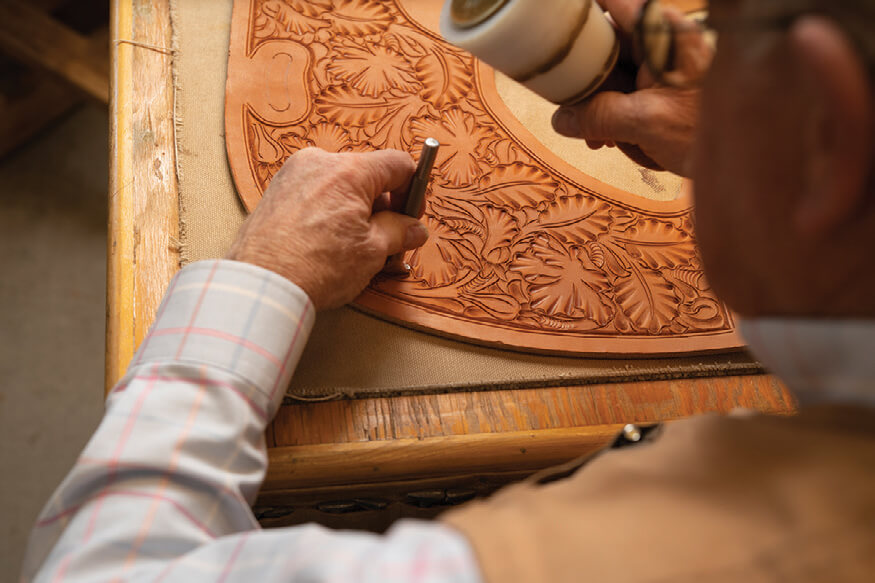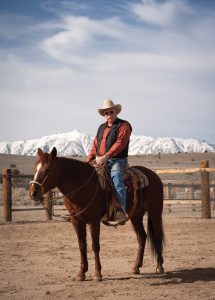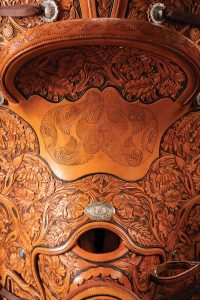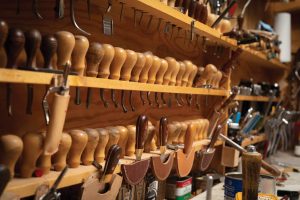
03 Aug A Life in Leather
Doug Cox is a world-renowned saddlemaker. Operating out of Gardnerville, Nevada — an unincorporated town in rural Douglas County, population 6,200 — he’s been in the custom saddle trade for half a century. At 73, he moves with an unrushed grace that only tradesmen, still plying, seem able to possess in later years. His gravel appearance is a match to his voice, but there’s nothing coarse about him. The fit and finish of his dress are always just so, and in the ilk of most good listeners, you feel that he’s always five steps ahead of you.
“Small folks can pretty much ride anything,” Cox says with a chuckle. “When you become larger, things change. You should be able to ride a saddle all day long and still feel like you could go to town and party all night. That’s my prerequisite.”

The #1 Silver Mount-ed Saddle is currently available for $168,000.
Cox grew up on a steer ranch in Grangeville, Idaho. “We did not own it,” he says. “We were just the labor.” When he turned 7, his parents put him to work harvesting hay, milking cows, and feeding over 2,000 animals, bovine and equine. “You didn’t make money at home. You just got fed.” The real cowboy work — moving cattle — started when he was 8. “They had to be in front of grass on a strict basis. You were moving cattle here, there, everywhere. When you got to that point, you passed the dogs in rank,” Cox says with a smile.
Cox’s talent with leather emerged in ninth-grade shop class. His first project was a belt: Western style, stamped with flower designs. “[The teacher] couldn’t imagine that anyone in high school could do something like that,” Cox says, adding that soon his friends started asking for their own. “I stamped belts for beer money,” he says, laughing. In winter, he helped his father braid hackamores — the bitless bridles typical in Western riding — and repair their own saddles and gear. In his senior year, he started riding rodeo, trying his hand at saddle bronc and bareback events. “I got thrown on my head,” he recalls of his first go-round.

Cox uses a seat stick to smooth and polish the leather.
For many young men in the late 1960s, when it came to college selection, geopolitics trumped academic interest. “My mother told me, ‘If you don’t go, you’re going to end up in Vietnam.’” Cox chose Sheridan College, an agricultural school in northern Wyoming. “They impressed me because their two sports were basketball and rodeo,” he says.
He emerged as a freshman standout on the rodeo team, but the classwork didn’t appeal. Fortunately, there was another school in town: King’s Saddlery. The Kings — based in Sheridan since 1946 — were legendary makers of Western saddles, ropes, and tack. Today, they’re a household name still in operation. “After school, I’d go down to King’s Saddlery and drink coffee,” Cox remembers. “Bob King buckstitched belts. They were starting in making ropes.” And, of course, the saddles — considered by many to be among the finest in the world. “I’d just go there to hang out.”

A saddle horn is artfully encased with hand-engraved silver and wrapped with twisted silver wire.
Bored with college, Cox dropped out his sophomore year and started working on a ranch outside of Sheridan. The draft board caught wind. “They were watching me constantly to see when I was going to quit,” he says. He got drafted and joined the Navy, but “at that time, the life expectancy of a corpsman was about two seconds, so they needed a lot of corpsmen.” He was assigned to the Marine Corps.
While in Bremerton, Washington, awaiting overseas deployment, he worked as an assistant in a military orthopedics ward. “I got to study anatomy and physiology firsthand,” Cox says. “You were working with people with broken bones, serious injuries. You learned what happens when one muscle does this, the other muscle does the opposite. It gave me a basic idea of what happens when you’re riding a horse.”

An equestrian himself, Cox is pictured here with his horse, Mo, at his ranch in Gardnerville, Nevada.
If a doctor or a nurse presented a similar anecdote as part of their origin story, we’d nod and move on, but it’s unique coming from a saddlemaker. Cox’s hands-on education in biomechanics formed the foundation of everything he’d go on to do. “If you’re sitting on a horse and just riding along, the world’s pretty copasetic,” he says. “Now, if that horse sees a grizzly and jumps, you’re going to tense up. Your reaction should be to get your feet in front of you and maintain your position on his back, but in order to do that, you have to have somewhere for the muscles in your ass to go.”
His rodeo experience brought further insight. “The basic movements of staying on one of those sonsabitches corresponds to what you’re sitting in. That all came together with what a seat ought to be.”
Premium exotics like ostriches, camels, and elephants aside, from around 4200 BC to 1880 AD, all rides had hooves. When hooked to a cart or carriage, a horse is an engine; when ridden, it’s a vehicle. And vehicles must be managed. A tractor-trailer is a lot to steer, a Lamborghini, a rocket on wheels — but neither is a sentient being. Control on horseback is about more than getting there; it’s a constant essential, keeping the rider from injury or death.

This striking saddle is inspired by the 1940s Hamley Wade Fork Pattern. The tree was made by Robin Severe in Pendleton, Oregon.
We might not think of saddles as technology, but they’re among the most indispensable in human history. We began domesticating the horse somewhere between 4500 and 3000 BC, in or around Eastern Europe. For millennia, riders rode bareback. The first saddles, appearing between 700 and 500 BC, were simple cloth pads used by Assyrian cavalrymen and nomads of the Eurasian steppes. The technology grew from there. The first solid-treed saddles — felt or leather over a wooden frame, giving a more ergonomic shape — would not appear until ca. 200 BC in China. The first evidence of stirrups appears around 300 AD, also in China. The who-did-what-whens are hard to pin down, but the innovation trendline was toward more control, more comfort.

Ron Mewes of Nevada City, California hand makes the conchos from silver and 12K rose gold for all of Cox’s saddles.
In 711, Islamic Arabs crossed the Strait of Gibraltar into modern-day Spain and conquered large portions of the Iberian Peninsula. They brought their native horses (Arabian, Berber), solid-treed saddles (evolved from Chinese design), jinete riding style (a proto form of rodeo), hackamore bridles (the inherited style that Cox and his father braided on winter nights), and spurs. The Moors were expelled from Spain in 1492, but by then, their brand of horsemanship had been absorbed by the larger Spanish culture.
We might think of the horse as a native European, but their evolutionary homeland is the plains of North America. By the early Pleistocene, they’d spread to all corners of the globe but, for reasons unknown, went extinct in North and South America about 10,000 years ago. When Columbus arrived, there were no horses. Spanish conquistador Hernán Cortés reintroduced them to the continent in 1519. Colonization followed. For most Spanish settlers, the New World was unspeakably exotic, but for the cattle herders among them, known as vaqueros, it was much like home. Dry, open plains. Sparse grasses. To feed a large herd, you needed a lot of land. The Iberian vaqueros brought their methods and gear with them and would evolve into a new form of horseman: the cowboy.

The conchos are steam polished for their final gleaming finish.
“It’s all a melting pot,” Cox says, “but I have a fondness for the old buckaroo era and the West Coast cowboys.” “Buckaroo,” a term still used to describe the cowboy culture of America’s Great Basin, is believed by linguists to be an anglicized version of vaqueros. The old is always with us in the new.
After Vietnam, Cox moved back to Grangeville, Idaho and took a job cutting roads through logging country. When the snow came, the work dried up. “They’d tell you to sign up for your rockin’ chair money until spring. I sat down with a Burton’s Leather Craft catalog and ordered a load of tools. That’s when I started getting serious.”

Manny Gonzales of Calistoga, California hand engraves silver for a custom Doug Cox saddle.
He became a professional rodeo rider and worked leather to make ends meet. Belts. Handbags. Saddle repair. “I had one guy. He bought a Cadillac Eldorado and wanted me to flower stamp the interior for him. The pay was good. I got the armrests on the doors done, then he got drunk one night and ran the thing into a telephone pole. That was the end of my big-money project.”
By 1976, Cox was in his pro rodeo prime, competing every weekend and going on to win a regional championship. That fall, he got a call from Gerald Holes — scion of the Ray Holes Saddle Company based in Grangeville. When it came to leatherwork and saddle repair, Holes enjoyed a regional monopoly and Cox’s freelancing had not gone unnoticed. “Gerry was a little intimidated that I was cutting into their business, so he offered me a job.”
They hired him as an apprentice for $2.20 an hour. Cox worked his way up, making vice-grip plier holsters, chaps, and axe scabbards. “I started with those small projects, and the more I learned, the more they gave me to do. You went to work at 8 in the morning and quit at 5, and you kept your head down and worked your ass off.” Three years later, he was promoted to saddlemaker. “The one thing I had over everybody else there — I knew more about what it should feel like in the seat because I spent all my time sitting in one. They started getting letters from people who ordered saddles [and] complimented the seats. I realized I was getting where I needed to be.”

This solid-silver cantle back is remarkably detailed, a work of art in its own right.
Cox moved to Three Forks, Montana in 1981 to work at Three Forks Saddlery. He struck out on his own a year later, renting a workshop in Toston for a spell, then settling in Bozeman, where he remained until 2000. “I would go back to Montana in a heartbeat,” Cox says. “There’s still a lot of good country, and I have a lot of friends there. I try to go back once a year to get a good taste of it.”
Cox has been based in Gardnerville, Nevada for the past 23 years. He lives with his wife but is equally married to his trade. His shop is choked but tidy, every surface utilized, an extension and expression of the man who works there. In an almost unfettered solitude, Cox distills all he knows into functional works of art. “I like lots of silver, lots of flowers, lots of contrast, and dyed backgrounds. I like fancy. Plain doesn’t cut it in my book.”
Pricing starts at $4,250. “From there, the sky’s the limit,” he says. His Visalia-style saddle is a showpiece and a showstopper, no expense or labor spared, and it could be yours for a cool $168,000. Most Cox saddles cost around $6,000 and, depending on the grade of embellishments, $10,000 is not uncommon. “People can get kind of shocked when they go to a custom saddlemaker and inquire about pricing. I always tell them, ‘If you stay in the horse-riding game, you’ll eventually come back to me.’”

An astonishing number of hand tools is required to create all of Cox’s ornate, one-of-a-kind saddles.
There’s an ancient Samurai legend. A swordsmith, the greatest in the land, has spent his life fashioning the finest blades known. Now aged and ill, the master retreats to his forge a final time, locks himself in for weeks, and emerges with the perfect sword — a flawless sword — a blade that he, nor any other smith, will ever surpass. He holds his creation aloft, glinting it in the sun, and announces, “My work is done.” He then impales himself, committing seppuku, and dies on the spot.
Cox has nothing so dramatic planned, but the same spirit is within him. “If you ever make the perfect saddle, you’re done,” he says. It’s a matter of honor. Cox’s work is the work of eons; the mastery of it — of its form, function, and tradition — continues to drive him. He can never settle because his discipline has never settled. If it had, we’d still be riding on cloth pads like the Assyrians.
“After finishing a saddle, you sit back, and realize there are a billion things you could have done better,” Cox says without a trace of hyperbole. “Not to say it was a wreck. It’s just to say there’s always something you could have done to make it better.”




No Comments